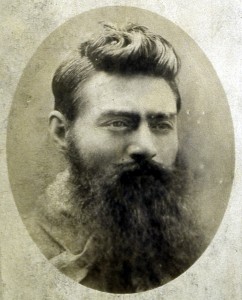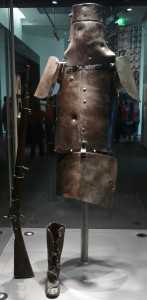 Australian bushranger, bank robber, cop killer and folk hero Ned Kelly was executed in 1880 at Old Melbourne Gaol. As a condemned prisoner, his body was given to science for dissection. After the doctors were done with him, his body was buried in an unmarked mass grave on the Old Melbourne grounds. His head was given to phrenologists to study, then returned to the police who used it as a paperweight. When Old Melbourne Gaol was closed in 1929, the mass grave was opened and the remains transferred to Pentridge Prison and reinterred.
Australian bushranger, bank robber, cop killer and folk hero Ned Kelly was executed in 1880 at Old Melbourne Gaol. As a condemned prisoner, his body was given to science for dissection. After the doctors were done with him, his body was buried in an unmarked mass grave on the Old Melbourne grounds. His head was given to phrenologists to study, then returned to the police who used it as a paperweight. When Old Melbourne Gaol was closed in 1929, the mass grave was opened and the remains transferred to Pentridge Prison and reinterred.
During the move, workers took parts they thought had belonged to Ned Kelly, including a skull. They turned out to belong to an Ernest Knox, executed and buried in 1894, but the site foreman sent the skull to the Australian Institute of Anatomy in Canberra thinking it was Kelly’s. Meanwhile, the skull that the police had been cheerfully desecrating for years also wound up in the Australian Institute of Anatomy in Canberra. It was put on display until stolen in 1978. It turned up again in 2009 but when tested turned out not to be Ned’s head at all — it might have belonged to Frederick Deeming, one of many Jack the Ripper suspects — so it seems the skulls were switched at some point when it was on display or perhaps even earlier when it was bouncing around the police station.
With all this body parts confusion, the location of Ned Kelly’s remains has been something of a mystery. Inspired by the surfacing of the possible Kelly skull, in 2008 archaeologists found a mass grave on the site of Pentridge Prison. The remains of 32 bodies were jumbled in the pit, so even if they had found the spot they hadn’t found Ned Kelly yet.
Now, 131 years after his death, Ned Kelly’s remains have been conclusively identified by researchers at the Victorian Institute of Forensic Medicine.
To confirm whether the 25-year-old Kelly’s skeleton was among the remains stored in the mortuary, scientists took DNA samples from each set of remains. Each DNA profile generated was then compared with mitochondrial DNA – the best tool to establish connections across generations – extracted from the blood of Melbourne art teacher Leigh Olver, a great-grandson of Kelly’s sister Ellen.
The results could not have been clearer. ”Leigh Olver’s mitochondrial DNA is the same as Ned Kelly’s,” institute director Stephen Cordner said yesterday. ”Among a grave of 24 unidentified people believed to include Ned Kelly is a set of human remains … bones which have a mitochondrial DNA profile the same as Leigh Olver’s and therefore Ned Kelly.”
But there was more to come. The project’s scientific leader David Ranson said it was unlikely Kelly’s wish for his body to remain untouched after death was granted, as the ”saw cut” marks on the neck vertebra are consistent with a post mortem examination.
 Osteological examination of the remains also uncovered gunshot injuries that match the ones Ned Kelly is known to have sustained in the shootout at the Glenrowan Inn that resulted in his arrest. Although he and his gang had some magnificent handmade armor made, with Biblical poetry, from plow blades forged over brush fires into helmets, breast plates, back plates and aprons, some police bullets still managed to meet their target. Prison doctor Andrew Shields, who examined Kelly before his execution, wrote up detailed descriptions of the injuries. Just as Shields had described, forensic anthropologists found a bullet hole in his right shin with bullet fragments still embedded inside, a healing gunshot injury on the left elbow, and a fractured right toe with shrapnel.
Osteological examination of the remains also uncovered gunshot injuries that match the ones Ned Kelly is known to have sustained in the shootout at the Glenrowan Inn that resulted in his arrest. Although he and his gang had some magnificent handmade armor made, with Biblical poetry, from plow blades forged over brush fires into helmets, breast plates, back plates and aprons, some police bullets still managed to meet their target. Prison doctor Andrew Shields, who examined Kelly before his execution, wrote up detailed descriptions of the injuries. Just as Shields had described, forensic anthropologists found a bullet hole in his right shin with bullet fragments still embedded inside, a healing gunshot injury on the left elbow, and a fractured right toe with shrapnel.
Next up for Ned: burial in a marked grave. His descendants will get to make the decision of where Ned Kelly’s remains will find their eternal rest at last, but politicians are antsy about it because of course his grave will be an enormous tourist draw. The town of Greta in Victoria, an area known as “Kelly Country” because it’s the family bought a large parcel of land after Ned’s Irish convict father died, is hoping Ned will be buried in the same cemetery where his mother, uncle and cousin are buried.